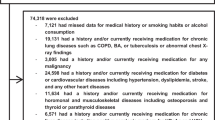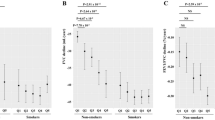Abstract
Objective:
The objective of this study was to investigate the association between antioxidant nutrients and markers of oxidative stress with pulmonary function in persons with chronic airflow limitation.
Design:
Cross-sectional study exploring the association of antioxidant nutrients and markers of oxidative stress with forced expiratory volume in the first second (FEV1%) and forced vital capacity (FVC%).
Setting/Subjects:
The study data included 218 persons with chronic airflow limitation recruited randomly from the general population of Erie and Niagara counties, New York State, USA.
Results:
After adjustment for covariates, multiple linear regression analysis showed that serum β-cryptoxanthin, lutein/zeaxanthin, and retinol, and dietary β-carotene, β-cryptoxanthin, lutein/zeaxanthin, vitamin C, and lycopene were positively associated with FEV1% (P<0.05, all associations). Serum vitamins β-cryptoxanthin, lutein/zeaxanthin, and lycopene, and dietary β-cryptoxanthin, β-carotene, vitamin C, and lutein/zeaxanthin were positively associated with FVC% (P<0.05, all associations). Erythrocytic glutathione was negatively associated with FEV1%, while plasma thiobarbituric acid-reactive substances (TBARS) were negatively associated with FVC% (P<0.05).
Conclusion:
These results support the hypothesis that an imbalance in antioxidant/oxidant status is associated with chronic airflow limitation, and that dietary habits and/or oxidative stress play contributing roles.
This is a preview of subscription content, access via your institution
Access options
Subscribe to this journal
Receive 12 print issues and online access
$259.00 per year
only $21.58 per issue
Buy this article
- Purchase on Springer Link
- Instant access to full article PDF
Prices may be subject to local taxes which are calculated during checkout
Similar content being viewed by others
References
Andreassen H, Vestbo J (2003). Chronic obstructive pulmonary disease as a systemic disease: an epidemiological perspective. Eur Resp J Suppl 46, 2s–4s.
Armstrong D, Browne R (1994). The analysis of free radicals, lipid peroxides, antioxidant enzymes and compounds related to oxidative stress as applied to the clinical chemistry laboratory. Adv Exp Med Biol 366, 43–58.
Block G, Coyle LM, Hartman AM, Scoppa SM (1993). HHHQ-DIETSYS analysis software, Version 3.0. National Cancer Institute: Bethesda, MD.
Block G, Hartman AM, Dresser CM, Carroll MD, Gannon J, Gardner L (1986). A data-based approach to diet questionnaire design and testing. Am J Epidemiol 124, 453–469.
Britton JR, Pavord ID, Richards KA, Knox AJ, Wisniewski AF, Lewis SA et al. (1995). Dietary antioxidant vitamin intake and lung function in the general population. Am J Resp Crit Care Med 151, 1383–1387.
Browne R, Armstrong D (1998a). Simultaneous determination of serum retinol tocopherols and carotenoids by high pressure liquid chromatography. In D Armstrong (ed). Methods in Molecular Biology, Free Radicals and Antioxidant Protocols. Humana Press: Totowa, NJ, pp 269–275.
Browne RW, Armstrong D (1998b). Reduced glutathione and glutathione disulfide. Methods Mol Biol 108, 347–352.
Cantin AM, North SL, Hubbard RC, Crystal RG (1989). Normal alveolar epithelial lining fluid contains high levels of glutathione. J Appl Physiol 63, 152–157.
Dekhuijzen PN, Aben KK, Dekker I, Aarts LP, Wielders PL, van Herwaarden CL et al. (1996). Increased exhalation of hydrogen peroxide in patients with stable and unstable COPD. Am J Respir Crit Care Med 154, 813–816.
Forman MR, Lanza E, Yong L-C, Holden JM, Graubard BI, Beecher GR et al. (1993). The correlation between two dietary assessments of carotenoid intake and plasma carotenoids concentrations: application of a carotenoid food-composition database. Am J Clin Nutr 58, 519–524.
Grievink L, de Waart FG, Schouten EG, Kok FJ (2000). Serum carotenoids, alpha-tocopherol, and lung function among Dutch elderly. Am J Resp Crit Care Med 161, 790–795.
Hankinson JL, Odencrantz JR, Fedan KB (1999). Spirometric reference values from a sample of the general US population. Am J Respir Crit Care Med 159, 179–187.
Heffner JE, Repine JE (1989). Pulmonary strategies of antioxidant defense. Am Rev Respir Dis 140, 531–554.
Holden JM, Eldridge AL, Beecher GR, Buzzard IM, Bhagwat SA, Davis CS et al. (1999). Carotenoid content of US foods: an update of the database. J Food Comp Anal 12, 169–196.
MacNee W (2000). Oxidants/antioxidants and COPD. Chest Suppl 117, 303S–317S.
McCormick DG, Greene HL (1994). Dinitrophenyl hydrazine method. In: Burtis C, Tietz NW (eds). Tietz Textbook of Clinical Chemistry. WB Saunders: Philadelphia, PA, pp 1275–1316.
Miller N, Rice-Evans C (1993). A novel method for measuring antioxidant capacity and its application of monitoring the antioxidant status in premature neonates. Clin Sci 84, 407–412.
Montuschi P, Collins JV, Ciabattoni G, Lazzeri N, Corradi M, Kharitonov SA et al. (2000). Exhaled 8-isoprostane as an in vivo biomarker of lung oxidative stress in patients with COPD and healthy smokers. Am J Resp Crit Care Med 162, 1175–1177.
Nadeem A, Chhabra SK, Masood A, Raj HG (2003). Increased oxidative stress and altered levels of antioxidants in asthma. J Allergy Clin Immunol 111, 72–78.
Olson JA (1999). Carotenoids. In: Shils ME, Olson JA, Shike M, Ross AC (eds). Modern Nutrition in Health and Disease. Lippincott, Williams and Wilkins: Philadephia, PA, pp 525–541.
Palace VP, Khaper N, Qin Q, Singal PK (1999). Antioxidant potentials of vitamin A and carotenoids and their relevance to heart disease. Free Radic Biol Med 26, 746–761.
Pauwels RA, Buist AS, Calverley PM, Jenkins CR, Hurd SS (2001). Global strategy for the diagnosis, management, and prevention of chronic obstructive pulmonary disease. NHLBI/WHO Global Initiative for Chronic Obstructive Lung Disease (GOLD) Workshop summary. Am J Respir Crit Care Med 163, 1256–1276.
Pippenger CE, Browne R, Armstrong D (1998). Regulatory antioxidant enzymes. In: Armstrong D (ed). Methods in Molecular Biology, Free Radicals, and Antioxidant Protocols. Humana Press: Totowa, NJ, pp 299–313.
Rahman I, Morrison D, Donaldson K, MacNee W (1996). Systemic oxidative stress in asthma, COPD, and smokers. Am J Respir Crit Care Med 154, 1055–1060.
Rahman I, Swarska E, Henry M, Stolk J, MacNee W (2000). Is there any relationship between plasma antioxidant capacity and lung function in smokers and in patients with chronic obstructive pulmonary disease? Thorax 55, 189–193.
Rahman I, Skwarska E, MacNee W (1997). Attenuation of oxidant/antioxidant imbalance during treatment of exacerbations of chronic obstructive pulmonary disease. Thorax 52, 565–568.
Romieu I, Trenga C (2001). Diet and obstructive lung diseases. Epidemiol Rev 23 (2), 268–287.
Schünemann HJ, Freudenheim JL, Grant BJB (2001a). Epidemiologic evidence linking antioxidant vitamins to pulmonary function and airway obstruction. Epidemiol Rev 23, 248–267.
Schünemann HJ, Grant BJB, Freudenheim JL, Muti P, Browne RW, Drake JA et al. (2001b). The relation of serum levels of antioxidant vitamins C and E, retinol and carotenoids with pulmonary function in the general population. Am J Resp Crit Care Med 163, 1246–1255.
Schünemann HJ, McCann S, Grant BJB, Trevisan M, Muti P, Freudenheim JL (2002). Lung function in relation to intake of carotenoids and other antioxidant vitamins in a population-based study. Am J Epidemiol 155, 463–471.
Schünemann HJ, Muti P, Freudenheim JL, Armstrong D, Browne R, Klocke RA et al. (1997). Oxidative stress and pulmonary function. Am J Epidemiol 146, 939–948.
SPSS for Windows (2001). Release 11.0.1 (November 2001).
Taylor JC, Madison R, Kosinska D (1986). Is antioxidant deficiency related to chronic obstructive pulmonary disease? Am Rev Respir Dis 134, 285–289.
Thomas JA (1999). Oxidative Stress and Oxidant Defense. In: Shils ME, Olson JA, Shike M, Ross AC (eds). Modern Nutrition in Health and Disease. Lippincott, Williams and Wilkins: Philadephia, PA, pp 751–760.
Tucker KL, Chen H, Vogel S, Wilson PWF, Schaefer EJ, Lammi-Keefe CJ (1999). Carotenoid intakes, assessed by dietary questionnaire, are associated with plasma carotenoid concentrations in an elderly population. J Nutr 129, 438–445.
US Department of Agriculture, Agricultural Research Service (1999). USDA nutrient database for standard reference, Release 13. 1999. Nutrient Data Laboratory Home Page,http://www.ars.usda.gov/ba/bhnrc/ndl.
Acknowledgements
This work is supported in part by a grant from the American Lung Association to Holger Schünemann and AA-0902 from the National Institute on Alcohol Abuse and Alcoholism. The authors thank the personnel at the Center for Preventive Medicine, University at Buffalo, for their contribution to the study.
Author information
Authors and Affiliations
Corresponding author
Additional information
Guarantors: HJ Schünemann and HM Ochs-Balcom.
Contributors: HMO-B contributed to the data acquisition, data analysis, data interpretation and manuscript preparation. BJBG contributed to the data interpretation, statistical supervision and review of the final draft. PM participated in design, funding, data interpretation and review of the final draft. CTS contributed to the statistical supervision, data interpretation and review of the final draft. JLF participated in design, funding, helped with data interpretation, review of the final draft. RWB measured the oxidative stress and antioxidant biomarkers, contributed to the data interpretation and review of the final draft. SEM contributed to the analysis of dietary antioxidant intakes, data interpretation and review of the final draft. MT participated in design, funding, data interpretation and review of the final draft. PAC contributed to the manuscript preparation and data interpretation. LI contributed to the data interpretation and review of the final draft. HJS contributed to the study design, data acquisition, funding, data analysis, data interpretation and manuscript preparation.
Rights and permissions
About this article
Cite this article
Ochs-Balcom, H., Grant, B., Muti, P. et al. Antioxidants, oxidative stress, and pulmonary function in individuals diagnosed with asthma or COPD. Eur J Clin Nutr 60, 991–999 (2006). https://doi.org/10.1038/sj.ejcn.1602410
Received:
Revised:
Accepted:
Published:
Issue Date:
DOI: https://doi.org/10.1038/sj.ejcn.1602410
Keywords
This article is cited by
-
Potential of hydroethanolic leaf extract of Ocimum sanctum in ameliorating redox status and lung injury in COPD: an in vivo and in silico study
Scientific Reports (2023)
-
Functional food: complementary to fight against COVID-19
Beni-Suef University Journal of Basic and Applied Sciences (2022)
-
Therapeutic effects of intranasal tocotrienol-rich fraction on rhinitis symptoms in platelet-activating factor induced allergic rhinitis
Allergy, Asthma & Clinical Immunology (2022)
-
Effects of ambient fine particulate matter on oxidative stress, inflammation, and janus kinase/signal transducer and activator of transcription signal molecules: a panel study of asthmatic adults in Taiyuan, China
Air Quality, Atmosphere & Health (2022)
-
Plasma vitamin C concentrations and risk of incident respiratory diseases and mortality in the European Prospective Investigation into Cancer-Norfolk population-based cohort study
European Journal of Clinical Nutrition (2019)



